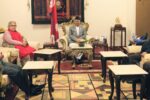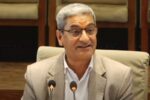KATHMANDU: Economic Digest, a daily morning email digest, is basically a relatable summation of important business news from Nepal into easy-to-understand summaries.
Gold price down by Rs 900 per tola
KATHMANDU: The price of gold has decreased by Rs 900 per tola on Friday.
According to the Federation of Nepal Gold and Silver Dealers Association (FENEGOSIDA), the precious yellow metal is being traded at Rs 74,600 per tola today.
It was priced at a fresh all-time high of Rs 76,500 per tola on Wednesday.
Similarly, the price of silver has decreased by Rs 15 and is priced at Rs 885 per tola today.
No ‘immediate impact’ of Middle East tensions on Nepali Petro market: NOC
The price of crude has jumped in the international market after Iran fired more than a dozen ballistic missiles at the two Iraq-based US Base camps.
The Nepal Oil Corporation (NOC), however, has said that the Nepali market will not witness a ‘big immediate impact’.
The state-owned oil monopoly purchases fuel from India. Many had assumed that the situation in the Middle East will have an impact on the Nepali market as India imports over 80 percent of crude oil from Middle East countries including Iran.
NOC said that the price will slightly increase in the Nepali market with a hike in the international market but there will be no impact on the supply of petroleum products.
“We will not hike petrol prices randomly,” said NOC Managing Director Surendra Poudel.
He said that the Indian Oil Corporation (IOC) has assured them of a regular supply of fuel.
Poudel said they are in regular contact with IOC officials.
Nepali banks halt gold import as demand falls
KATHMANDU: The banks of Nepal have halted imports of gold, after a notable decline in demand in the domestic market.
According to Anil Sharma, executive director of Nepal Bankers’ Association (NBA), the stock of raw gold with banks are on a high, as demand has plummeted. As per estimates, the banks hold around 450 kilograms of raw gold.
The association has decided to temporarily halt new gold imports at least until that time when the existing gold inventory is cleared. The country allows imports of raw gold only through 16 authorized banks, who later sell them to jewelers.
Mohan Kumar Bishwokarma, president of the Federation of Nepal Gold and Silver Dealers’ Association noted that trade witnessed a significant drop in demand for gold and gold jewelry since mid-December last year, due to high prices.
The customers are seen avoiding fresh buys, waiting for a correction in prices, he added. Incidentally, domestic gold prices in Nepal had hit an all-time record, surpassing Rs. 76,500 per tola on Wednesday.
Indian import restrictions could impact Nepal’s exports
The Indian Government’s decision to impose restrictions on the import of palm oil is expected to disrupt Nepal’s exports. In recent times, palm oil exports have made up a considerable portion of Nepal’s exports.
Data provided by the Trade and Export Promotion Centre indicate that palm oil worth Rs 11.5 billion was exported over the first five months of this fiscal year.
In the 2018/19 fiscal year, Nepal exported palm oil worth Rs 10.33 billion solely to India. That amounted to 10% of Nepal’s total export earnings.
The spokesperson for the Ministry of Industry, Commerce and Supplies, said that the ministry had been in touch with the Indian Embassy in Kathmandu to discuss the status of imports from Nepal. The ministry is currently unsure whether the new law poses complete restriction or a fixed quota for imports.
SEZ problems are being addressed: Minister Bhatta
In response to the complaints by the business community and industrialists, who expressed that Bhairahawa Special Economic Zone (SEZ) is not an industry-friendly environment, the government is preparing to take program-based initiatives to work out the problems.
The Bhairahawa SEZ was established by the government in hopes of reducing the trade deficit and getting closer to economic prosperity. Lekhraj Bhatta, the Minister for Industry, Commerce and Supplies, said that the ministry would form a committee to address the issues being raised in the SEZ and monitor future progress.
Bhairahawa SEZ, which was set up in 2001, currently has only three industries in operation. One of the main problems in the SEZ I the shortage of electricity supply. The deputy executive director of Nepal Electricity Authority (NEA) said that NEA would supply 15 Megawatts of power to the SEZ within a month.
Two industrial villages in the making
Industrial villages are to be developed in two local governments for the promotion of entrepreneurship through the use of local resources, skills and technology.
The government has accepted the concept for developing industrial village following preliminary feasibility research in both areas, said Baglung municipality mayor Janak Raj Poudel. The industrial village is predicted to contribute to foster employment opportunities and economic prosperity through the mobilization of local resources and means. Locals are thrilled with works in progress for establishing an industrial village at Taragaun rural municipality – which is far ahead in agriculture, livestock, minerals, and timber products.
Experts stress the need to fill infrastructure investment gap
Government inefficiency and low productivity blamed for the failure to increase capital expenditure. Experts cited several factors—including government inefficiency, policies, processes and ways of setting and executing priority projects—that Nepal needed to improve to meet the infrastructural needs and attract large-scale private and foreign investments.
Former finance minister Ram Sharan Mahat said that the government’s inefficiency and poor factor productivity were the reasons behind the country’s failure to amplify capital expenditure and attract and use investments in the capital sector.
Experts also say that the country needs to develop its ways of randomly distributing resources for ineffective schemes, and setting and executing priority projects, as well as blocking leakages and wastage of the infrastructure budget.
Finance minister claims the country is on the course of broad-based economic growth
The World Bank says Nepal’s economy will expand by only 6.4 percent in the current fiscal year, well below the government target of 8.5 percent.
Nepal’s Finance Minister has asserted that the country’s economy is heading towards broad-based growth in light of concerns that growth might stumble this fiscal year due to sluggish spending by both the government and the private sector.
Adding that the country had improved the investment climate as there is no load-shedding or labor problems, and legal reforms are undergoing.
The Prime Minister Employment Programme has invited criticism from various quarters for its nature of distributing cash to unemployed youths for different projects instead of creating an environment where they could get jobs.
Finance Minister Khatiwada defended the government’s initiative as measures that needed to be taken to make certain of the fundamental rights envisioned by the constitution.
Six years on, Nepal’s first economic zone struggles to find investors
This fiscal year, the government has allocated Rs820 million budget for the economic zone in Bhairahawa but not a single rupee has been spent. However, the government is still moving ahead with its plan to create more special economic zones in Jumla, Panchkhal, Gorkha, Dhangadhi and Biratnagar.
It also comes at a time when the special economic zone in Simara is having a hard time finding tenants. The industry housed by the special economic zone has been requesting the government to cut down the existing provision of exporting 60 percent of production.
Earlier, it was 75 percent. Similarly, they have asked the government to reduce the rental fee. Dinesh Bhattarai, secretary at the Ministry of Industry, Commerce and Supplies, stated the lack of coordination among government bodies has created obstacles for the development of the special economic zones. Adding, the special zone was urbanized to increase export to minimize the trade deficit but so far, the zone remains an isolated area.
MoFE gearing up to revise EIA threshold rules
A new policy, which requires preparing the Environmental Impact Assessment (EIA) is being drafted by the government. This policy will apply to projects with investments above Rs 2 billion.
The Ministry of Forest and Environment (MoFE) is revising the Environment Protection Guideline by raising the minimum investment threshold which requires EIA.
The current law requires mandatory EIA for projects with an investment of Rs 250 million and above.
However, following recommendations from the Ministry of Industry, Commerce and Supplies (MoICS) and other ministries, MoFE made the revision the review of the current situation.
The EIA requirements for low investment projects had long been discouraging small investors and the private sector had been urging the government to make this change. Following the increase in threshold, investment in the country is expected to be more encouraging.
(Compiled and prepared by Swastik Aryal, Akash Shrestha, Nitish Lal Shrestha, Diana Zulkifli)
Economic Digest is a daily morning email digest, basically relatable summations of the most important business news and happenings from Nepal into easy-to-understand summaries. By realizing that readers are faced with a packed calendar, the Institute for Strategic and Socio-Economic Research (ISSR), Nepal’s independent think tank, and Khabarhub — Nepal popular news portal — have joined hands to disseminate news from Nepal by creating news summaries in the form of Economic Digest.









Comment